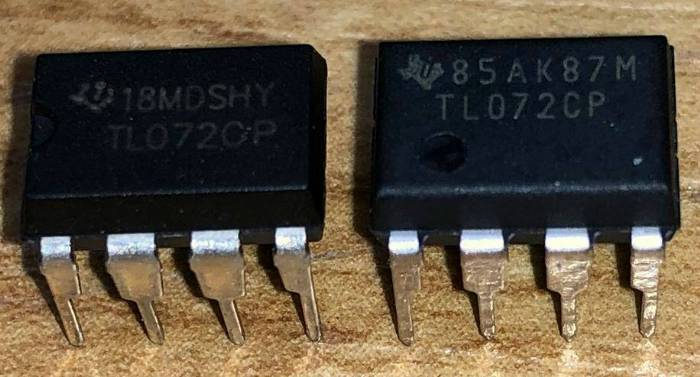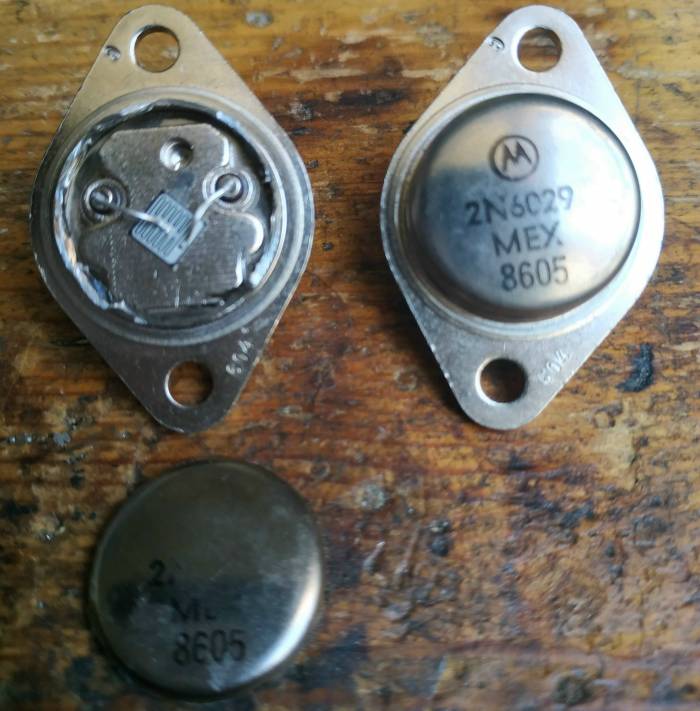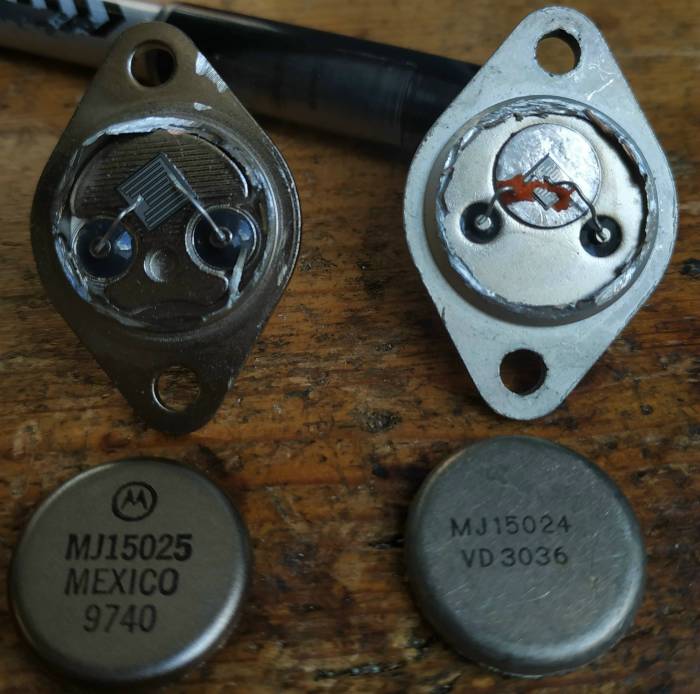

|
| Elliott Sound Products | Counterfeit Semiconductors - 4 |
Last Update - September 2019
 Main Index
Main Index
 Counterfeits Index
Counterfeits IndexI'm unsure why, but there seem to be people selling (and buying) these transistors, despite the fact that they appear to have been rendered obsolete around 2003 or thereabouts. Certainly, I could find no mainstream supplier listing them, but (naturally) they are all over ebay, and they aren't cheap there either. Most sellers insist they are 'genuine', but this is presumably a 'new meaning' of the word, of which I was previously unaware.

Fake 2SA1553 And 2SC4029 Transistors
The above photo was sent to me in July 2018, and the transistors were purchased from ebay. The tiny die is typical of all counterfeit power transistors. It's certainly utterly incapable of withstanding 15A or a maximum dissipation of 150W - the die is simply way too small. When subjected to even a fraction of the rated power, the die will fail. If you buy any obsolete device, it's essential to run a SOA (safe operating area) test (see Semiconductor Safe Operating Area).
In general, I cannot ... ever suggest using obsolete transistors for new builds, and for repairs you are generally better off with more modern devices. You do need to be very careful though, because there's often a good chance that an older amplifier may oscillate with new (especially higher fT) transistors. This may mean that the caps included for stability need to be changed, not something for the faint-hearted. In some cases, it may not be possible to get a stable result, which means that the power stage probably needs to be replaced with something else.
Be aware too that some 'mainstream' transistors may well be marked with their original designations, but that doesn't mean that the new part is the same as the original. This can also lead to amplifiers becoming unstable when output (or driver) transistors are replaced. It goes without saying that fake devices will never match the originals, other than the number printed on the case. Most blow up as soon as any significant load is applied.
Not what you'd expect, as this is a low-cost opamp even when purchased from major suppliers (AU$1.25 from a major UK supplier for example). At around $0.17 each from China, it looks too good to be true, and that is indeed the case. The fake device was unstable, and oscillated regardless of the presence (or otherwise) of bypass capacitors. Even the slightest capacitance at the output caused oscillation, which can happen with any opamp, but when the 'real thing' was installed the problem went away. You can see in the photo that the TI logo is not right, and the other printing is nothing like it should be.

Fake TL072 Opamp (Left), Genuine (Right)
The 'fake' device is shown on the left, with the 'real' one on the Right. It's probable that the poorly marked and misbehaving TL072 is actually a 'factory reject', destined for disposal, but 'rescued' and sold on by an unscrupulous employee perhaps. These were purchased on eBay (predictably), and while they may have been only a few cents each, they are obviously just a waste of money. It might be possible to use them in something, but they will be unpredictable and aren't fit for use.
Thanks to Daniel G. for the info and photograph.
I don't have any photos of this, but the AD633 analogue multiplier normally costs around AU$22.00 or more, but (of course) you can get them from Ali Express for only $2.00. While ebay is a great source of fake parts, at least you have some possibility of recompense by lodging a complaint. Ali Express may claim to do the same, but I don't like your chances. If you pay 10% of the normal price for an expensive IC, then there's a 90% probability that it will be a fake.
From a reader in France ...
These came from old stock of a self-entrepreneur in France. This person is dead. The batch of transistors dates back to the 2000s, and were present with a whole stock of 'Marantz' stamped transistors. I unfortunately do not have more information.

Fake 2N6209
I send you an email about fake transistors: 2N6029. The inscriptions fade with acetone. The beta gain is 300 instead of 100 maximum. The square does not have the same inscriptions on the surface. Motorola have obviously never made this transistor. screen printing on the surface is doubtful.
It appears that the 2N6209 and its complement (2N3773) were custom made for Marantz by Motorola. As with any custom device, information is hard to come by. There seems to be little info on-line about this device, and while the reader submitted the photos, it's hard to be certain if the device pictured above is a fake or not. The die looks to be a sensible size, and it's fitted with a substantial heat-spreader. However, no manufacturer's part numbers should come off with acetone so one has to be suspicious. 

Genuine MJ15025 (Left), Fake MJ15024 (Right)
It fails after 2/3 turns of the amplifier. (Not sure what this means, as the text was provided via Google translate). The real transistor is on the left, the wrong is on the right. The fake is embedded in a clear orange silicone.
While this information is obviously historical, it also demonstrates that fake devices cover the entire range of devices, from the most popular to the most obscure.
Although faking a 2N3055 might seem pointless (at best), these (and all) TO-3 devices are now quite expensive. With 'brand name' devices from reputable suppliers, you can expect to pay around AU$10.00 each. This isn't because they are anything special, but there's a lot more effort needed to build a TO-3 all metal package than the now common plastic packages (TO-247 or similar). Some major US suppliers have 2N3055 transistors for less than US$2.00 but most are a great deal more.
On that basis, it stands to reason that if you see someone selling 10 of them for AU$13.00, there is very little likelihood that they will be genuine. They will almost certainly have a much smaller die than required for the 115W power rating, or may be factory rejects that someone managed to get for scrap metal value. I've seen many branded 'ST' (STMicroelectronics), but they are listed as obsolete. This shouldn't come as a surprise, as there are many transistors available now that are vastly superior in all respects.
Part of the problem is that people see old circuits that seem interesting, and because most beginners (in particular) don't understand how to select a replacement device from those available now, the imagine that they have to use the original devices specified. This is a gold mine for those of ill-will who will capitalise on any opportunity. Well, maybe not really a gold mine, but it's an outlet at least. People get caught all the time, with all fakes.
I was alerted to this by a reader in Poland, and while he did send photos, they were from somewhere else and I don't have permission to republish them. Just be aware, and remember that the 'real thing' from a reputable supplier will (usually) cost far more than a couple of dollars. Anything at that price is almost certainly a fake. If sold on any of the on-line auction sites, you'll almost certainly get counterfeits.
MJ2955 transistors (the TO-3 PNP complement to the 2N3055) are likewise almost certainly fakes. In general, avoid Alibaba and eBay for power transistors, and if the price looks too good to be true, then it almost certainly is.
 Main Index
Main Index
 Counterfeits Index
Counterfeits Index